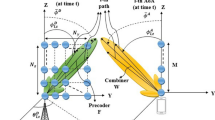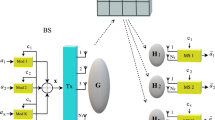Abstract
In this paper, the issue of two-dimensional direction of arrival estimation in monostatic multiple-input–multiple-output (MIMO) radar with double parallel uniform linear arrays is studied, and an algorithm based on estimation of signal parameters via rotational invariance techniques (ESPRIT) is proposed. Through a series of reduced-dimensional transformations, the proposed algorithm has very low complexity due to the low dimension. Meanwhile, the estimation performance of the proposed algorithm is slightly improved compared to the conventional ESPRIT, especially in low signal-to-noise ratio. Furthermore, the algorithm can estimate azimuth and elevation angles without additional pair matching in monostatic MIMO radar. Error analysis of the angle estimation and Cramér–Rao bound are derived. Simulation results verify the usefulness of our algorithm.











Similar content being viewed by others
References
Fishler, E., Haimovich, A., Blum, R. S., Cimini, L. J., Chizhik, D., & Valenzuela, R. A. (2004). MIMO radar: An idea whose time has come. In Proceedings of IEEE radar conference (pp. 71–78), Baton Rouge, April 2004.
Li, J., & Stoica, P. (2006). MIMO radar-diversity means superiority. In Proceedings of 14th adaptive sensor array process. Workshop (ASAP ’06), Lincoln Lab, MA, USA, December 2006.
Fishler, E., Haimovich, A., Blum, R. S., Chizhik, D., & Valenzuela, R. A. (2006). Spatial diversity in radars models and detection performance. IEEE Transactions on Signal Processing, 54(3), 823–838.
Fuhrmann, D. R., & Antonio, G. S. (2004). Transmit beamforming for MIMO radar systems using partial signal correlation. In Proceedings of 38th Asilomar conference on signals, systems and computers (Vol. 1, pp. 295–299), November 2004.
Xu, L., Li, J., & Stoica, P. (2006). Adaptive techniques for MIMO radar. In Proceedings of 4th workshop on sensor array and multichannel, signal processing (pp. 258–262), July 2006.
Robey, F. C., Coutts, S., Weikle, D. D., McHarg, J. C., & Cuomo, K. (2004). MIMO radar theory and experimental results. In Proceedings of 38th Asilomar conference on signals, systems and computers (Vol. 1, pp. 300–304), November 2004.
Li, J., Stoica, P., Xu, L., & Roberts, W. (2007). On parameter identifiability of MIMO radar. IEEE Signal Processing Letters, 14(12), 968–971.
Bekkerman, I., & Tabrikian, J. (2006). Target detection and localization using MIMO radars and sonars. IEEE Transactions on Signal Processing, 5(10), 3873–3883.
Xu, L., Li, J., & Stoica, P. (2008). Target detection and parameter estimation for MIMO radar systems. IEEE Transactions on Aerospace and Electronic Systems, 44(3), 927–939.
Zhang, J., Zhang, L., & Liu, N. (2009). Maximal likelihood DOA estimation of MIMO radar. System Engineering and Electronic, 31(6), 1292–1294.
Duofang, C., Baixiao, C., & Guodong, Q. (2008). Angle estimation using ESPRIT in MIMO radar. Electronics Letters, 44(12), 770–771.
Jinli, C., Hong, G., & Weimin, S. (2008). Angle estimation using ESPRIT without pairing in MIMO radar. Electronics Letters, 44(24), 1422–1423.
Yan, H., Li, J., & Liao, G. (2008). Multitarget identification and localization using bistatic MIMO radar systems. EURASIP Journal on Advances in Signal Processing, 1–8. Article ID283483.
Xia, W., & He, Z. (2008). Multiple-target localization and estimation of MIMO radars using Capon and APES techniques. In IEEE radar conference, 2008. RADAR ’08 (pp. 1–6).
Zhang, X., & Xu, D. (2010). Angle estimation in MIMO radar using reduced-dimension Capon. Electronics Letters, 46(12), 860–861.
Liu, F., & Wang, J. (2010). AD-MUSIC for jointly DOA and DOD estimation in bistatic MIMO radar system. In 2010 International conference on computer design and appliations (ICCDA 2010) (Vol. 4, pp. 455–458).
Zhang, X., Xu, L., Xu, L., et al. (2010). Direction of departure (DOD) and direction of arrival (DOA) estimation in MIMO radar with reduced-dimension MUSIC. IEEE Communications Letters, 14(12), 1161–1163.
Bencheikh, M. L., & Wang, Y. (2010). Polynomial root finding technique for joint DOA DOD estimation in bistatic MIMO radar. Signal Processing, 90(9), 2723–2730.
Nion, D., & Sidiropoulos, N. D. (2009a). A PARAFAC-based technique for detection and localization of multiple targets in a MIMO radar system. In 2009 IEEE International conference on acoustics, speech and, signal processing pp. 2077–2080).
Nion, D., & Sidiropoulos, N. D. (2009b). Adaptive algorithms to track the PARAFAC decomposition of a third-order tensor. IEEE Transactions on Signal Processing, 57(6), 2299–2310.
Zhang, X., & Xu, D. (2011). Low-complexity ESPRIT-based DOA estimation for collocated MIMO radar using reduced-dimension transformation. Electronics Letters, 47(4), 283–284.
Zhang, X., Huang, Y., Chen, C., et al. (2012). Reduced-complexity Capon for direction of arrival estimation in a monostatic multiple-input multiple-output radar. IET Radar, Sonar & Navigation, 6(8), 796–801.
Xia, T., Zheng, Y., Wan, Q., & Wang, X. (2007). Decoupled estimation of 2-D angles of arrival using two parallel uniform linear arrays. IEEE Transactions on Antennas and Propagation, 55(9), 2627–2632.
Zheng, Z., Li, G., & Teng, Y. (2012). Simplified estimation of 2D DOA for coherently distributed sources. Wireless Personal Communications, 62(4), 907–922.
Li, J., Zhang, X., & Chen, H. (2012). Improved two-dimensional DOA estimation algorithm for two-parallel uniform linear arrays using propagator method. Signal Processing, 92(12), 3032–3038.
Xin, J., Zheng, N., & Sano, A. (2007). Simple and efficient nonparametric method for estimating the number of signals without eigendecomposition. IEEE Transactions on Signal Processing, 55(4), 1405–1420.
Rao, B. D., & Hari, K. V. S. (1989). Performance analysis of ESPRIT and TAM in determining the direction of arrival of plane waves in noise. IEEE Transactions on ASSP, 40(12), 1990–1995.
Stoica, P., & Nehorai, A. (1990). Performance study of conditional and unconditional direction-of-arrival estimation. IEEE Transactions on Signal Processing, 38(10), 1783–1795.
Acknowledgments
This work is supported by China NSF Grants (61371169, 61071164), Jiangsu Planned Projects for Postdoctoral Research Funds (1201039C), China Postdoctoral Science Foundation (2012M521099), Open project of key laboratory of underwater acoustic communication and marine information technology (Xiamen University), Hubei Key Laboratory of Intelligent Wire1ess Communications (IWC2012002), Open project of Key Laboratory of Nondestructive Testing (Nanchang Hangkong University), Open project of Key Laboratory of modern acoustic of Ministry of Education (Nanjing University), the Aeronautical Science Foundation of China (20120152001), PAPD of Jiangsu Higher Education Institutions, Funding for Outstanding Doctoral Dissertation in NUAA (BCXJ13-09), Funding of Jiangsu Innovation Program for Graduate Education (CXZZ13_0165), Qing Lan Project and the Fundamental Research Funds for the Central Universities (NS2013024, NZ2012010, kfjj120115, kfjj20110215).
Author information
Authors and Affiliations
Corresponding author
Rights and permissions
About this article
Cite this article
Li, J., Zhang, X., Chen, W. et al. Reduced-Dimensional ESPRIT for Direction Finding in Monostatic MIMO Radar with Double Parallel Uniform Linear Arrays. Wireless Pers Commun 77, 1–19 (2014). https://doi.org/10.1007/s11277-013-1491-3
Published:
Issue Date:
DOI: https://doi.org/10.1007/s11277-013-1491-3




